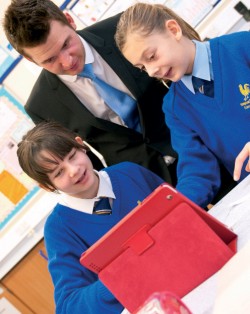
In these times of enforced austerity, there are few things certain branches of the media seem to enjoy more than being able to raise readers' hackles through sharing a revelation of wilful extravagance in the public sector. So when it became public knowledge towards the end of last year that Honywood Community Science School in Coggeshall, Essex, had 'handed out iPad 2s to each of its 1,200 students at a cost of almost £500,000', a flurry of indignant stories in the press was inevitable. 'What financial crisis?' squawked the Daily Mail in tones of high sarcasm, for example, before quoting the Taxpayers' Alliance ('...money intended for pupils' education is instead being spent on devices to play games on'), and wheeling out a random 'former head teacher' to add his take on the affair ('It's the thin end of a wedge... students should want education for their own sake not because of material giveaways...')
Interestingly, however, there was very little comment from the head teacher of the school in question, Simon Mason, himself. Which was a shame, because had any journalists bothered to dig a little deeper into what is happening at Honywood, they would have discovered that investing in what Mason refers to simply as 'a personalised tool for learning' for all pupils is just one, relatively insignificant element of a much more potentially explosive story. There's an educational revolution going on at this oversubscribed and high performing academy, in fact... and focusing on the gadgetry (which, as it turns out, is on a pragmatic three-year lease; at the end of that period, the iPads will be returned, and the school will go back into the market) is a bit like filing a report about the building of a brand-new factory with exclusive emphasis on what colour the doors will be.
In the beginning...
"I started thinking about this when I was doing my degree, in the early 1980s,' begins Mason, as we settle for a pre-tour cuppa in his office – 'this' being a philosophy of learner-led education that has most recently resulted in the introduction of a completely new and innovative curriculum for Honywood's 2011 Y7 intake. "I had the opportunity to work for the School for Independent Study, which was a faculty of the NE London polytechnic, where they ran degree and masters programmes for people who had been unsuccessful in education, giving them access through interview to courses they determined and designed themselves. I realised then that learning could be very different from how it had been presented to me at school and indeed as a university student. It was like walking into a parallel universe."
Mason's first chance to put some of his ideas about education into action came in 1991, when he arrived at Burnt Mill School, Harlow, to teach business studies. "I developed an entirely student-centred GCSE course," he explains. "When I got there, 11% of young people were achieving a grade C or better in the subject; by the time I left it was 62%, in an area that was considered deprived. And it wasn't a function of my shining personality," he adds with a self-deprecating grin, ever aware of the dangers of appearing Messianic. "It was about the design of how learning was planned for these young people, many of whom had aspirations that were much lower than they should have been. I thought, for example, it was important that students engage with local businesses. So during the learning sessions, they would be allowed to leave, to go into the town and conduct research, entirely driven by their own decision-making. It was considered a pretty radical approach – and of course, some abused it. But what that gave me was an opportunity for those young people to talk to me about why their outcomes weren't as good as they should be, and realise that it was due to mismanagement of their time in the local park. That's where real learning occurs – when you can engage in discussion around failure, in a context. We learn when we are not doing things particularly well, after all. And that's very different from chasing a model of compliance."
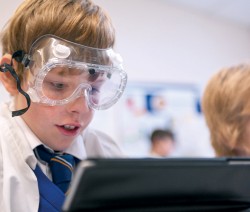
After six years teaching business studies, and following a period as deputy head, Mason was appointed head teacher at Honywood in 2002. He joined the school with one, simple vision – to create the experience of learning that his business studies classes had enjoyed in Harlow, for all the children, across all subjects. However, he faced a somewhat paradoxical barrier; people naturally tend to be considerably more open to a dramatic change of approach when the current one is demonstrably not working. And Honywood was far from unsuccessful. Results had been on an upward trend for at least seven years – surely it would be madness for the new guy to come in and start 'fixing' what wasn't broken in the first place?
"I wasn't a knight on a white horse," agrees Mason, levelly. "But at the same time, it's fair to say there were underlying things that weren't going well. I did a staff survey, and nine out of ten respondents told me that behaviour was unacceptable, for example. Walking around the school it was clear there was a learning model that was utterly passive. So over the first four years we focused on getting staff to change the way lessons worked and making them more interactive, so young people could get up and engage with that didactic process. The children absolutely loved it. We started to get more motivation to learn; behaviour improved hugely... and the results went up."
Going further
In 2005, Mason and his leadership team introduced two major developments, with the aim of demonstrating to parents, inspectors, and – not least – his own educators, that an empowered learning model could be universally effective. 'Focus Days' stripped the curriculum out for particular days in the year; and a 'Discovery Week' for Y9 pupils involved no timetable at all, replacing it with a series of problems to be solved independently. "What colleagues were in many cases surprised to discover," Mason points out, "was that the quality of the outcomes were so much higher than they'd seen in previous models, when they'd been determining how good the work could be by the way they'd structured the task."
As the message sank in, Mason knew that he had the green light to move forwards. "Last year, our results were 68%; the best in the school's 48-year history," he observes. "But two years before that, when we hit our new highest – 65% at that time – I had to question why, in the best year we'd ever had, 35% of our youngsters didn't meet the government benchmark. How could that be good enough? It wasn't. We weren't going to accept that."
In asking what was lacking for the 35%, rather than basking in the reflected glory of the 'successful' majority, Mason and his team identified a set of 16 key skills needed for a learning-centred model, which the school wasn't delivering. And so, over 24 months, they developed a curriculum that was as much learning-, as learner-based, explicitly incorporating these snappily branded 'Honyskills' in every lesson. "We've created a mechanism for talking about learning which is completely different from what we had before," concludes Mason. "And we've got the most motivated group of learners we've ever seen at the school. Every young person desperately wants to be successful, to learn, and be happy. The problem is, with most models of learning they can't see how to do it."
Breaking boundaries
Every lesson for Honywood's Y7 students is presented with a 'split screen' approach – meaning that Honyskills are given just as much emphasis as the subject-specific knowledge and skills that learners need to acquire. In addition, for 25 minutes, four days a week, there is something called 'learning session 3', in which learners specifically work on their Honyskills, following the 'Honybrain programme', which encourages them to understand and articulate the ways they are learning across the curriculum.
A change in language has proven to be immensely empowering; children are 'young people', and 'learners' – not pupils. A lesson is a 'learning session' (and lasts for 100 minutes), and even the world 'work' has been edged out of the lexicon, in favour of 'designs for learning', incorporating challenges and opportunities for autonomy. There are no 'learning objectives'; how could there be? And there's no streaming, either, because according to Mason, this limits aspiration – when learning is genuinely individualised, there are no artificial boundaries.
And those oh-so-controversial iPads? As far as Mason is concerned, it's obvious – if you are going to empower children in their learning you need to make sure they have completely independent access to the necessary resources. At the moment, the Apple tablets effectively fulfil that function, and for a mere 2.3% of the school's annual budget. It really is as simple as that. "This isn't dogma," insists Mason. "We'll be doing this programme with children for five years, assessing and talking with families throughout, and making adjustments if necessary. We've already run a learning review with every single Y7 learner and his or her family. The children had been with us for nine weeks at that point – and the parents couldn't believe how well we knew them, and how far their own self-awareness had already progressed. Yes, we have some caregivers who are anxious (especially about maths, for some reason, which is why we've held special parents' evenings to explain how this kind of learning works with the subject), but ultimately, the proof will be the outcomes we are able to achieve – for everyone, not just the top 65, 70, or even 80%. Our mission is about two things: success and happiness. And we are sure those two things are connected."
Model pupils
So, what does this 'learning-centred model of education' look like in action? During our visit, we observed a range of Y7 learning sessions, including science, French and music. The level of engagement was impressive – in small groups or individually, the young people were without exception 100% focused on their learning throughout, making decisions about resources (frequently opting for pencil and paper, or craft supplies, it should be noted, in addition to or instead of the iPad) and direction, including taking their learning out of the classroom and into the corridor where necessary, with no permission sought or required. An irresistible atmosphere of creativity, curiosity and excitement was practically tangible... and, perhaps most tellingly of all, every teacher seemed relaxed, confident, and to be having just as good a time as his or her class.
"I didn't expect secondary school to be as good as it is," says Y7 learner Amy Edwards. "I think the Honyskills are an interesting take; they're used in every class and in a way, they're something to work for. My strongest at the moment is probably 'working independently', and my least strong is 'empathy' – it's hard to bring it into lessons other than drama. I realise we have to take our GCSE choices in Y8, but I'm not scared. I know what I'd pick now – I'm quite secure in that. And the school has the resources to help me get the grades I'm capable of. The iPads are really useful, not only for the apps and access to the internet, but also because if you have a problem, you can contact a teacher at any time, or even join in a chat room to share advice with staff and other children in your position. I love the fun challenges we do – in French recently, we had to design a lesson for Y6 children, and the prize is actually to go and teach that lesson – it's really exciting!"


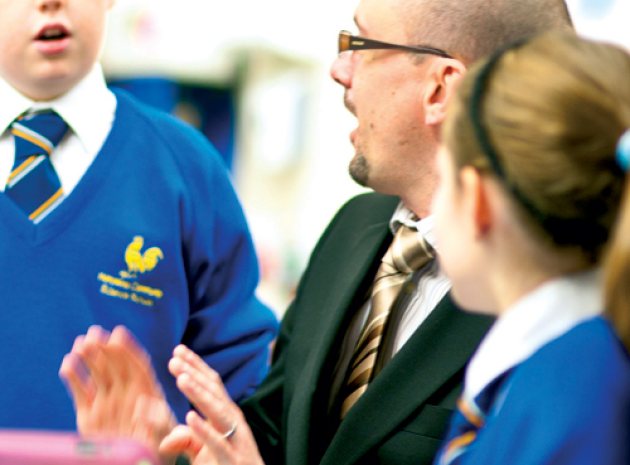



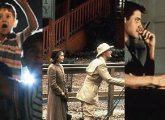

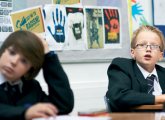


“Ultimately, the proof will be the outcomes we are able to achieve – for everyone not just the top 65, 70 or even 80%”